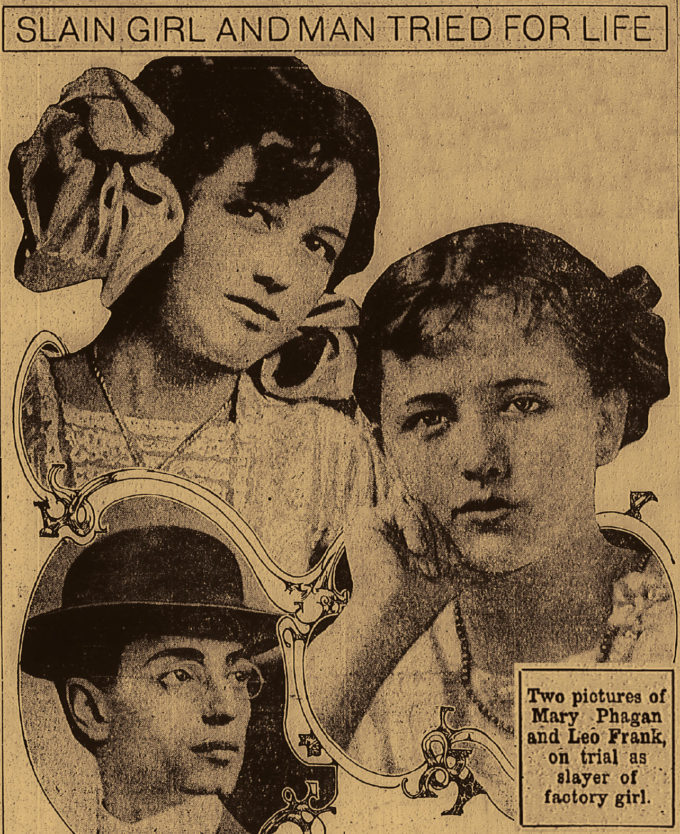Another in our series of new transcriptions of contemporary articles on the Leo Frank case.
Atlanta Georgian (Hearst’s Sunday American)
July 27th, 1913
As Leo Frank faces to-day the ordeal decreed by law that for man’s life, man’s life shall pay, interest in his case that has held Atlanta, Georgia and the South enthralled for three months has diminished not a whit since the Sunday morning the body of the little factory girl was found.
Wise judges of news, men who are paid thousands of dollars each year for their knowledge of the fickleness of the public, men who can time to the second the period when interest dies in one thing before the public eye to be born anew in another, have for years contended that no single item of news can sustain its interest longer than one brief week.
And yet for three months the public has read of Mary Phagan’s death and the quest for her slayer and their demand for this news has been insatiable.
That the vaunted insight of these news experts is as shallow as the mirror reflection of a beauty of the stage is the thought that common logic first presents.
The insight of these experts has not been at fault. On the contrary, it has been sustained. For in the mystery veiling the death of Mary Phagan and the trial of Leo Frank as her slayer, a more varied array of things that interest, thrill, horrify, shock and make men think is presented than in any one case developed since typesetting machines made the modern newspaper possible.
Harry Thaw’s case comes to mind, that tragedy of romance that presented in the same cast of characters the brilliant Lothario, the man of millions, and a woman as fair as the dawn. But there was never the element of mystery in the slaying of Stanford White. District Attorney Jerome described it pretty well as a commonplace tragedy of the tenderloin.
The only question that confronted the public was whether there was a law decreed by God that a man should take up arms and avenge his family honor that should nullify the law made by man that decreed that the courts of the country and the judgement of heaven could alone mete out reparation for personal injury.
But in the Phagan case, there is a mystery so deep, so impenetrable, that there are thousands in Atlanta who believe that Mary Phagan’s slayer walks about to-day a free man as another battles for his life accused of his crime.
Victim Only a Child.
There was mystery in the famous case of Henry Clay Beattle, the Virginia aristocrat, who met death in the electric chair for slaying his wife after his infatuation for Beulah Binford.
But again, we have a feature of the Phagan case which was missing in the Beattle tragedy that makes the Atlanta mystery as grippingly pitiful as the Virginia problem was sordid.
For in the Phagan case a child is one of the principals. All the world may love a lover, but all the world loves a child more. And when the innocent, wistful, appealing face of the little factory girl first appeared in the public prints more heartstrings were touched than there were thrills caused in all the sinister revelations of the Virginia trial.
The child interest has made many a case appeal to the public interest more than struggles of statesmen, ravages of nature, or even the love of man for woman. The entire United States waited breathlessly for news of the capture of the kidnapers of little Billy Whitla, the sturdy Pennsylvania lad, in 1909.
But when the kidnapers were taken and Billy Whitla returned safe and sound and maybe a little happier from his thrilling experience to the home of his parents, the public forgot all about little Billy and to-day, in four short years, there are few who remember his case at all. For Billy Whitla lived. Mary Phagan died.
Lamana Case Was Absorbing.
In 1907 the hearts of every mother and father in the Southland bled for the wealthy father and mother of the little Lamana boy, who was taken from their New Orleans home by members of the Crescent City Mafia. Interest was intense at every period of the search and public sentiment was kindled near to the blazing point when the beheaded body of the boy was found in a Louisiana swamp.
But was thrilling as was the Lamana case, it did not have that quality that is so essential to make a case universally absorbing. The Lamanas were foreigners, the kidnapers were foreigners. And Americans want an American in their news stories.
And so on and on. Recall any case of thrilling interest to your mind, analyze it, and you will discover that the Phagan case has features which that case does not possess and any one of those features would make a story of breathless interest in itself.
That is why public interest in the slaying of the factory girl has not lagged for one day since the discovery of the crime; that is why during the trial of Leo M. Frank Judge Roan’s court room will hold the interest of every American, be he banker or beggar, be he black or white; be he churchman or sinner.

